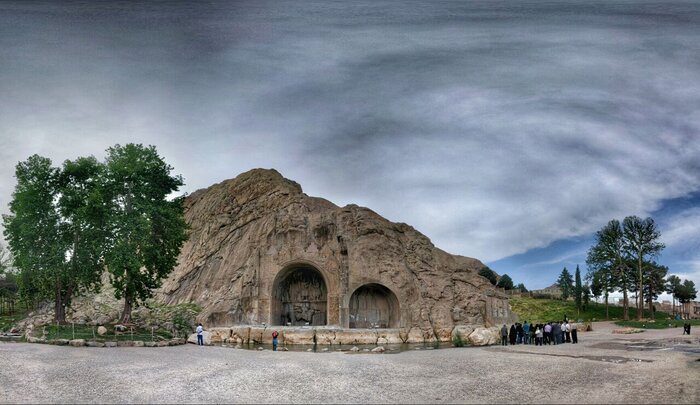Kurd horse, Sassanid landscape closer to UNESCO tags

TEHRAN – Together with Iraq, Iran is completing all-inclusive dossiers for a Sassanid archeological landscape in the western province of Kermanshah as well as the Kurd horse, to have them registered on the UNESCO World Heritage list, Kermanshah’s tourism chief has said.
Considering that these dossiers are multinational in nature, Iran and Iraq have worked together to facilitate the registration of these projects globally separately from Iran’s quota, Daryush Farmani explained on Tuesday.
These cases will be completed using all necessary resources so that Kermanshah can gain a new World Heritage site, he added.
Persian-Kurdish horse, also known as the Kurd horse and originated in Kermanshah province, constitutes a group of horses traditionally bred and used by Kurdish People who have lived and occupied today’s western provinces of Iran for several millennia.
The breed originates from western Iran, where the mountainous topography and moderately cold climate have sculpted a unique horse population resistant to harsh environmental conditions.
Back in December, a provincial tourism official announced that the dossier may be registered internationally because it is also bred in the Kurdish regions of Iraq, Turkey, and Syria, he said.
As part of the process to include Kurd horses on the intangible world heritage list, this dossier is being prepared under the title of knowledge and skill for breeding and keeping Kurd horses, he noted.
With a high concentration on Taq-e Bostan, which embraces a magnificent series of large bas-relief carvings in Kermanshah, the Sassanid archeological landscape is sought to be extended to Ctesiphon, an ancient city located 32 km southeast of modern Baghdad that served as the winter capital of the Parthian empire and later of the Sassanid empire.
Taq-e Bostan embraces incredible Persian heritage on the base of a towering cliff, featuring extraordinary Sassanian bas-reliefs of ancient victorious kings.
Taq-e Bustan was originally the site of a Parthian royal hunting garden, but the Sassanians later added their own regal stamp. Its biggest alcove features elephant-mounted hunting scenes on the sidewalls and highlights the coronation of Khosrow II (r 590–628), beneath which the king rides off in full armor and chain mail (half a millennium before the European Black Prince made it fashionable.).
The second niche shows King Shapur III and his Roman-stomping grandfather Shapur II. To the right of the niches, is a fine tableau again showing Shapur II (r 379–383), in which he is depicted trampling over the Roman emperor Julian the Apostate (whom he defeated in 363) and receiving a crown of blessings from the Zoroastrian god Mithras.
It is said that late afternoon is the best time to visit, as the cliff turns a brilliant orange in the setting sun, which then dies poetically on the far side of the duck pond. The surrounding open-air restaurants rock out till late in the evening and the carvings are warmly floodlit. The site is 10km north of Kermanshah's city center.
The Sassanid era is of very high importance in the history of Iran. Under Sassanids, Persian architecture and arts experienced a general renaissance. Architecture often took grandiose proportions such as palaces at Ctesiphon, Firuzabad, and Sarvestan which are amongst the highlights of the ensemble.
Generally, a Sassanid archaeological landscape represents a highly efficient system of land use and strategic utilization of natural topography in the creation of the earliest cultural centers of the Sassanid civilization.
In 2018, an ensemble of Sassanian historical cities in southern Iran, titled “Sassanid Archaeological Landscape of Fars Region”, was named a UNESCO site. The ensemble comprises eight archaeological sites situated in three geographical parts of Firuzabad, Bishapur, and Sarvestan.
The World Heritage reflects the optimized utilization of natural topography and bears witness to the influence of Achaemenid and Parthian cultural traditions and of Roman art, which latter had a significant impact on the architecture and artistic styles of the Islamic era.
Apart from architecture, crafts such as metalwork and gem engraving grew highly sophisticated, yet scholarship was encouraged by the state. In those years, works from both the East and West were translated into Pahlavi, the language of the Sassanians.
Kermanshah embraces a variety of awe-inspiring historical sites, including Taq-e Bostan and the UNESCO-registered Bisotun.
Bisotun is a patchwork of immense yet impressive life-size carvings depicting king Darius I and several other figures. UNESCO has it that Bisotun bears outstanding testimony to the important interchange of human values in the development of monumental art and writing, reflecting ancient traditions in monumental bas-reliefs.
Kermanshah was founded in the 4th century CE by Bahram IV of the Sassanid dynasty. Conquered by the Arabs in 640, it was called Qirmasin (Qirmashin). Under the Seljuk rule in the 11th century, it was the chief town of Kordestan. The Safavids (ruled 1501–1736) fortified the town, and the Qajars repulsed an attack by the Turks during Fath Ali Shah’s rule (1797–1834). Occupied by the Turkish army in 1915 during World War I, it was evacuated in 1917. The construction of a road in the 1950s over the age-old Khorasan track added considerably to the importance of the city.
ABU/
Leave a Comment